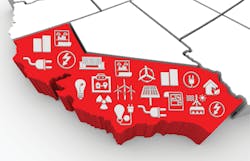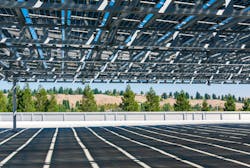What’s new for lighting controls in the upcoming Title 24
Commercial building energy codes regulate the designed energy efficiency of nonresidential buildings to minimize energy consumption. While most states adopt model codes and standards, the State of California developed its own code, Title 24, Part 6: Building Energy Efficiency Standards.
Historically, California’s energy code has led the nation in terms of innovation and strictness, pioneering energy-saving measures that have been adopted by model codes and other jurisdictions. It is enforced by local building departments as part of the permit application process.
Lighting and lighting control requirements are both detailed and robust. For example, the provisions require a broad range of controls to ensure general lighting is turned off or reduced when it is not needed based on input conditions such as occupancy and demand response.
Since 1995, Title 24, Part 6 typically has been updated triennially. The latest version was finalized in 2021 and takes effect Jan. 1, 2023. To ensure compliance, lighting practitioners who conduct business in California should familiarize themselves with its requirements.
This article provides an overview of the code’s mandatory lighting control requirements and highlights major changes related to nonresidential buildings. For more detailed information, including interpretation and all exemptions, consult the code at energy.ca.gov.
Title 24 and lighting controls
Title 24, Part 6 allows a compliance path that is either prescriptive or performance. A prescriptive path means conformance with a set of restrictions; a performance path can be demonstrated through building modeling using software. Both have mandatory lighting provisions, the majority of which require the use of lighting controls in nearly all new construction projects as well as certain retrofit projects, both indoors and outdoors.
Required lighting controls include manual area, multilevel, automatic shutoff, automatic daylighting, and demand-responsive controls. The most relevant requirements are covered in the following code sections:
- Section 130.1: Mandatory Indoor Lighting Controls
- Section 130.2: Outdoor Lighting Controls and Equipment
- Section 130.4: Lighting Control Acceptance and Installation Certificate Requirements
- NA7.6: Lighting Control Acceptance Requirements
- NA7.7: Lighting Control Installation Requirements
- NA7.7.5.2: Acceptance Test for Institutional Tuning
- NA7.8: Outdoor Lighting Controls Acceptance Test
When viewed as a whole, the lighting control requirements in Title 24, Part 6 appear complex, but they generally become simpler when distilled to individual loads, such as general lighting in a classroom or office. See “Pre-checklist for interior lighting compliance” for a list of questions that can help lighting designers form the parameters for compliant solutions.
What’s new in Title 24
The 2022 version of California’s energy code contains many changes in the lighting and controls sections, not to mention notable improvements in clarity and consistency. Changes include updates to outdoor lighting zones, the nonresidential lighting power allowance tables, and demand response, as well as new requirements for occupancy sensing for office spaces—along with a clarification for occupancy sensors used with HVAC. Additionally, multifamily buildings were given their own code sections as an application, adding significantly to the body of the code.
The lighting control requirements in in the 2022 version of Title 24, Part 6 received many revisions, but two changes stand out: a requirement for occupant-sensing controls in office spaces larger than 250 ft2; and new requirements for demand-responsive controls.
Occupant-sensing controls may be used to comply with the energy code’s automatic shutoff requirements; in certain spaces, such as offices 250 ft2 and smaller, they are required. The new energy code requires occupant sensors to control general lighting in offices larger than 250 ft2; furthermore, each sensor’s zone must be no larger than 600 ft2. These requirements are similar to provisions in the 2018 and 2021 versions of the International Energy Conservation Code.
If the luminaires have an embedded sensor capable of autonomous luminaire control, each luminaire can be considered its own control zone. Undershelf and furniture-mounted task lighting controlled by a local switch and either a time switch or occupant sensor are exempted.
The sensor may automatically turn its zone’s lighting on to any level — including full power — upon detecting occupancy. Within 20 minutes of an individual control zone being unoccupied, it must uniformly reduce lighting power by at least 80% of full power. If a single zone is occupied, all other zones can remain illuminated at up to 20% of full power.
What is demand response?
A practice by which electric systems planners and operators balance supply and demand within energy grids. Consumers participate by reducing or shifting their electricity usage during set peak times in exchange for lower rates and other financial incentives. Energy providers may also cycle certain types of equipment, such as air conditioners and water heaters, on and off in direct load-control programs to help reduce grid overload.
Source: energy.govWithin 20 minutes of a sensor status indicating all zones in the controlled area are vacated, the system must turn all lights in all zones off.
Lighting designers will likely want to align their occupancy zones based on the lighting layout, even if it means dictating zones smaller than the 600-ft2 maximum. This code provision is expected to encourage adoption of products with luminaire-level lighting control (LLLC) and wireless networking capabilities.
Title 24, Part 6, Section 110.12: Mandatory Requirements for Demand Management underwent several significant updates related to demand response. This strategy enables lighting to reduce its loads automatically based on a signal from a demand-response system, which may originate with the utility.
Instead of basing its inclusion on building area (formerly a 10,000-ft2 minimum threshold), demand-responsive lighting controls are now required for any building with an installed general lighting load totaling 4000W or more.
Explicit exceptions include spaces where health or life safety, ordinance, or regulation do not permit general lighting to be reduced; the general lighting power in these spaces is not counted in the total load for purposes of comparing to the 4000W threshold. Another is alterations and additions that do not exceed 4000W.
The demand-responsive controls are subject to the requirements and exceptions specific to the energy code’s Section 130.1(b): Multi-Level lighting controls for mandatory indoor lighting controls. Areas less than 100 ft2 or with a lighting power density equal to or below 0.5W/ft2, restrooms, and any non-general lighting are excluded.
For compliance testing, the lighting controls must demonstrate a power reduction in controlled areas of at least 15% below the installed full lighting power. The signal may use a wired or wireless protocol as long as it is bidirectional. An OpenADR 2.0a or 2.0b Virtual End Note must be included that is certified by the manufacturer to automatically implement the required control function, or the lighting control manufacturer must certify that its system can respond to a demand response signal from another system’s OpenADR 2.0b Virtual End Node. If communications are disrupted, demand-responsive controls must continue to perform all other specified control functions.
The new edition of Title 24, Part 6 also expands demand-responsive controls to include plug loads. If the building is required to have both demand response from the lighting control system and plug load control, the automatically controlled receptacles must be capable of being turned off in response to a signal from the demand response system. This requirement ensures the capability of incorporating plug load control into demand response but does not require the owner to enact the strategy. Note that while small offices may not be required to have demand-responsive lighting, controlled receptacles in these spaces may be required to connect to the demand-responsive control system.
Check out the new code
While this article focused on two significant revisions in the 2022 version of Title 24, Part 6, many other updates to the lighting control requirements are scattered throughout the code. Additionally, new sections in the forthcoming code require photovoltaics and battery storage for many new nonresidential buildings. Designers, installers, and lighting practitioners need to understand the totality of these changes before they begin working on projects that go out for permit in California after Jan. 1, 2023.
Until then, lighting professionals should become thoroughly familiar with the new code. Manufacturers and other education sources, such as local chapters of the Illuminating Engineering Society, Energy Code Ace, and the Lighting Controls Association, can be helpful in this effort.
Pre-checklist for interior lighting compliance
1. What is the load type, building or area type, size of the load, and area dimensions?
2. Does the load require a dedicated manual switch, dimmer, or scene controller?
a. Is this device readily accessible to occupants in the space? Exemptions exist for stairwells, corridors, two-plus stall restrooms, parking areas, and areas of the building intended for access or use by the public.
b. Is this device located in the enclosed area? Specific exemptions allow mounting the area control device so lights can be seen from the switch location, or visually displaying their status.
c. Is continuously lighted egress lighting provided that should not be controlled by a local switch?
3. Should the general lighting load in a room be multilevel for flexibility? General lighting is ambient lighting that produces a uniform light level throughout an area; it does not include task or accent lighting.
a. If multilevel lighting is required, how many levels of flexibility and uniformity are required, based on the load type?
4. Does the area require automatic shutoff of lighting loads?
a. Generally, occupant sensors, time switches, or other control devices are allowed although some areas require specific types of occupant sensors.
b. If scheduling, is there a means for timed override?
c. What is the maximum allowed control zone for the application?
d. If occupant sensors are required, do they need to be manual or partial on? Do they need to be partial off, and if so, does the partial-off sensor need to be full off afterhours?
5. Is the load general lighting and located in one of the three types of daylit zones — toplit, primary sidelit, and secondary sidelit — thus requiring automatic daylighting controls?
a. What control steps are required from the daylighting controls?
6. Are the loads required to be capable of being reduced to meet demand response needs?
7. Are there opportunities for power adjustment factor credits to be gained by deploying lighting controls not specifically required by the energy code, enabling additional lighting wattage for the design?
8. Does the selected lighting control solution have the capability to control receptacles at the receptacle or circuit level?
Get to know our expert
CRAIG DILOUIE, LC, CLCP, is education director for the Lighting Controls Association, a council of the National Electrical Manufacturers Association dedicated to educating the public about lighting control technology and application. Learn more at lightingcontrolsassociation.org.
For up-to-the-minute LED and SSL updates, follow us on Twitter. You’ll find curated content and commentary, as well as information on industry events, webcasts, and surveys on our LinkedIn page and our Facebook page.

Craig DiLouie
Craig DiLouie, LC, CLCP, is education director for the Lighting Controls Association, a council of the National Electrical Manufacturers Association dedicated to educating the public about lighting control technology and application. Learn more at lightingcontrolsassociation.org.






